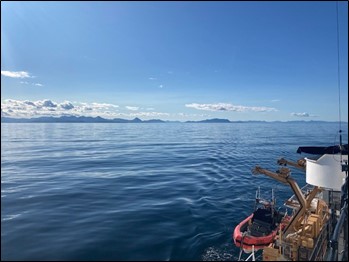LIFE IN KODIAK

Life in Kodiak:
Being homeported in Kodiak is a unique adventure. Life on Alaska’s “Emerald Isle” can be wonderful and wild. Summers are full of long periods of daylight, hiking, fishing, hunting, surfing, biking, boating, and exploring the second largest island in the United States. Winters on “The Rock” brings darkness, heavy wind and rain, and occasional bouts of ice and snow. Many just throw on some heavy weather layers and go do all the things you enjoyed doing in the summer!
Good rain gear, a taste for adventure, and a positive attitude are essential to a successful tour in Kodiak. Kodiak offers an exceptional array of opportunities. On-base facilities include a Commissary, Exchange, Movie Theater, Bowling Alley, and a modern gym with an indoor swimming pool. Off-base there is a Safeway and Wal-Mart approximately eight miles away. Low crime rates, good schools, a close-knit community, and plenty of year-round activities make it so that many families who get stationed here don’t want to leave.
Kodiak Background:
Kodiak Island was originally inhabited by the Sugpiaq people of the Alutiiq nation, who settled vast areas along Alaska’s southern coast. Throughout their history in Kodiak, these natives lived as hunter/gatherers, utilizing the island’s rich supply of coastal natural resources including a diverse array of salmon and other fish species, birds, and sea mammals. The arrival of Russian fur traders and missionaries in the late 18th century proved devastating for the Sugpiaq, and within a century the native population had suffered immense losses to disease and violence.
When Alaska was acquired by the U.S. from Russia in 1867, Kodiak was gradually settled by Americans who established a robust commercial fishing industry, which persists as a cornerstone of Kodiak’s economy to this day. Legislation enacted in 1941 during the Second World War set aside a large portion of the island as the Kodiak National Wildlife Refuge. This vast swath of territory remains largely uninhabited to this day, with only planes or boats providing access. The town of Kodiak harbors around 6,000 people, which ebbs and flows throughout the year as Coast Guard members and their families, fish industry workers, and tourists arrive and depart.
Kodiak remains a wild island and a paradise for those seeking experiences in the great outdoors. Hiking, camping, ATV riding, boating, animal watching, the northern lights, hunting, and fishing are all unforgettable experiences on Kodiak. The wildlife of Kodiak is central to the experience. The Kodiak brown bear is the largest species of grizzly, and these unique, beautiful creatures continue to thrive due to protections that were enacted to prevent their extinction. All five species of Pacific salmon enter numerous streams on the island in robust numbers. They feed bears, bald eagles, dolly varden char, rainbow trout, and humans alike on their journey to return to their spawning waters. Halibut, lingcod, and rockfish fill the depths just outside Kodiak harbor, and humpback whales provide spectacular imagery as they frequent the island’s waters in the summer to feed.
The weather in Kodiak is unique, and with milder extremes than other parts of Alaska. In the summer, temperatures range from 50–80 degrees with up to 18 hours of daylight. In the winter, temperatures range from 10–40 degrees and the window of daylight shrinks to 6 hours. There is plenty of precipitation in Kodiak, with approximately 70 inches of both rain and snow falling yearly!